Step 3. Create your puppy’s daily calendar
Make sure you have the an understanding of the Five Types of Puppy Appointments before moving to Step 3, and that you have gotten (or at least ordered) the Required Tools.
First you’ll need something to write your puppy’s schedule on. You can use my template or make your own. Enter your email below and I can send you a pdf template of the one I use. If you’d prefer to create your own, scroll down for instructions.
To make your own calendar template:
- Get a blank sheet of paper and a pen.
- Divide the sheet into three columns.
- In the left column, list the times from morning until night, divided into 15 or 30 minute slots – up to you.
- In the middle column, enter the heading “Me” or “My schedule”.
- In the last column, enter the heading “Puppy” or “Puppy Schedule”.
These instructions make a few assumptions:
1.All household members work full time day jobs away from the home.2. Someone will be coming home mid-day to check in on the puppy.
If these two conditions do not apply to you, don’t fret – you’ll just need to adapt the instructions to meet your situation. I promise it’s not rocket science! If you need help, I am available! 🙂
How to fill out the Puppy Calendar
Follow the steps below “quick n’ dirty” style. Don’t worry about being precise – rough time estimates are all you need. Shouldn’t take more than 30 minutes to complete.
Step 1.
Under the “Me” column, Enter the time you wake up and the time you go to bed on a typical day. Don’t worry about the weekend yet – just focus on the most common days.
Step 2.
Under the “Me” column, enter the time that you leave for work and the time that you (or someone else) will be back to check in mid-day. Repeat for the times you go back to work and return home for the evening.

Step 3.
In the “Me” column, draw an arrow from the times you leave to the times you next get home.
Step 4.
In the “Puppy” column, enter “Self-Amusement” in the corresponding time slots for any of those periods that you will be gone for longer than 3-4 hours.
If the periods are less than 3-4 hours, then you can mark either as “Rest” or “Self-Amusement”.
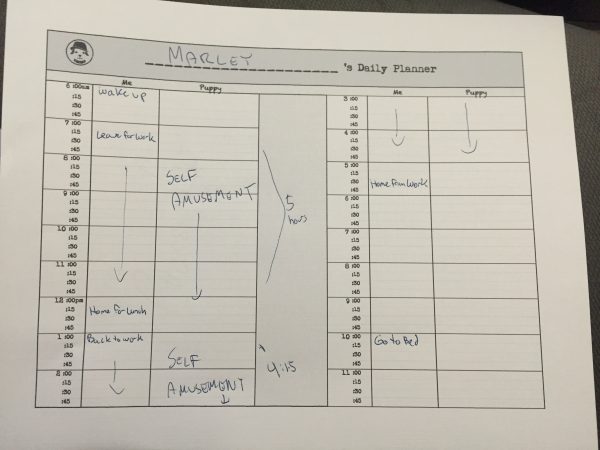
Step 5.
In the “Puppy” column, enter “Potty Break” for the first 15 minutes after you wake up and after each time you return home.
Step 6.
Now enter “Potty Break” for the 15 minutes before you go to bed and before each time you leave home.
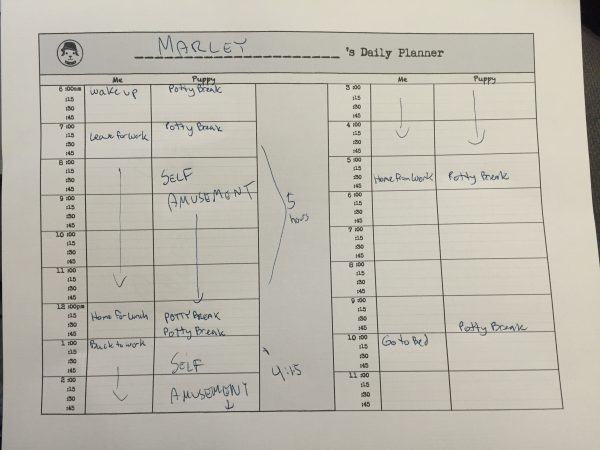
Step 7.
In the “Me” column, enter any personal tasks that take at least 15 minutes into any available time slots (eg. shower, make/eat dinner). Best to start personal tasks immediately after Potty Breaks.
Step 8.
In corresponding slots of the “Puppy” column, enter either “Self-Amusement” or “Rest”.
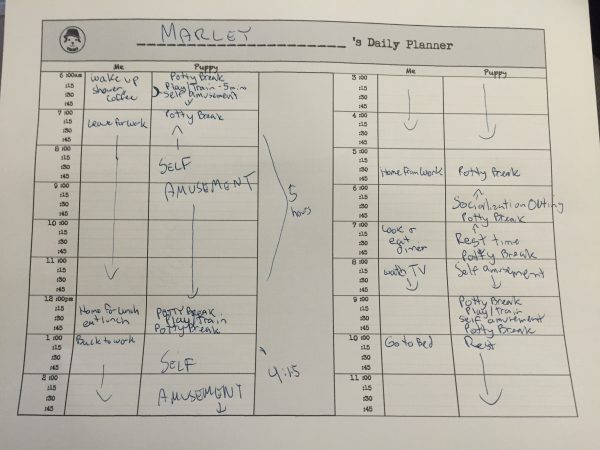
Step 9.
In the “Me” column, find an empty 30-60 minute time slot. In the corresponding “Puppy” slot, enter “Socialization Outing”.
You might need to slot in a “Potty Break” before and after the “Socialization Outing” depending on where you are taking them (i.e. if you’re going in the car, make sure you give a potty break before and after!).
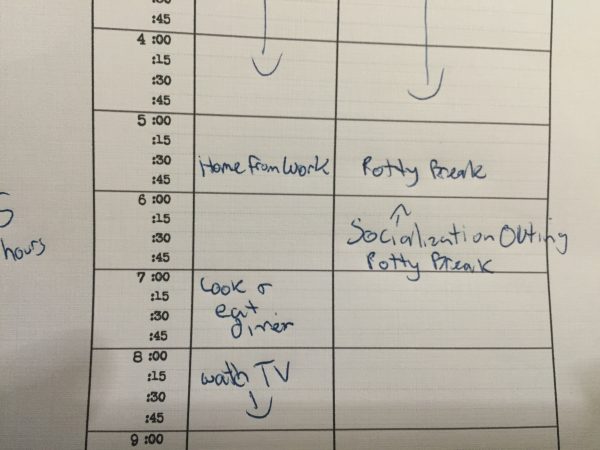
Step 10.
In the “Puppy” column, enter 15-30 minute periods of either “Train/Playtime”, “Self-Amusement”, or “Rest” in each empty slot that follows a “Potty Break”.
Step 11.
Repeat until your puppy’s calendar is full and there are no empty slots.
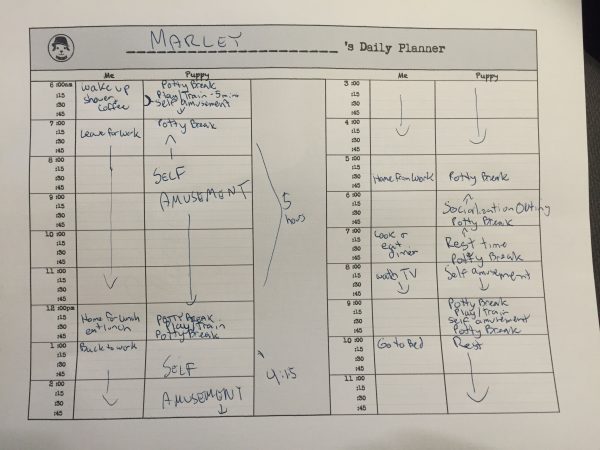
Step 12.
Implement the schedule and make adjustments as needed!!!
Notes
This is not meant to be a rigid schedule! It is just to provide yourself and your puppy with a general structure for the day. Feel free to swap Self Amusement, Rest, and Train/Play times on any given day. The goal is for you to have clear options for managing your puppy at any given time. And the puppy will soon learn to adjust their behavior according to each context – they will no longer need to guess “what comes next” and their body clocks will adjust.
If you have an inconsistent schedule or are home all day: It might be a bit more complicated, but the premise is the same. Schedule your “away” times and times that you need to “do stuff” as “Self-Amusement” or “Rest”, then alternate between “Train/Playtime”, “Self-Amusement”, and “Rest”, with “Potty Breaks” in between. Be sure to squeeze in a “Socialization Outing” as well!
Puppies vary in what they need. I estimated for the average puppy. Some puppies are more energetic than others. Others need to pee a lot more. You can’t change that stuff. But you might have to adjust their schedules to meet those needs. Listen to your puppy – if he can’t last 30 min indoors without peeing, then he’s telling you to try 20min instead!
It may take a few days for the puppy to acclimate to the new routine, especially if you are changing drastically from an old routine they’ve gotten used to. Don’t give up – and don’t be afraid to make adjustments to the calendar.